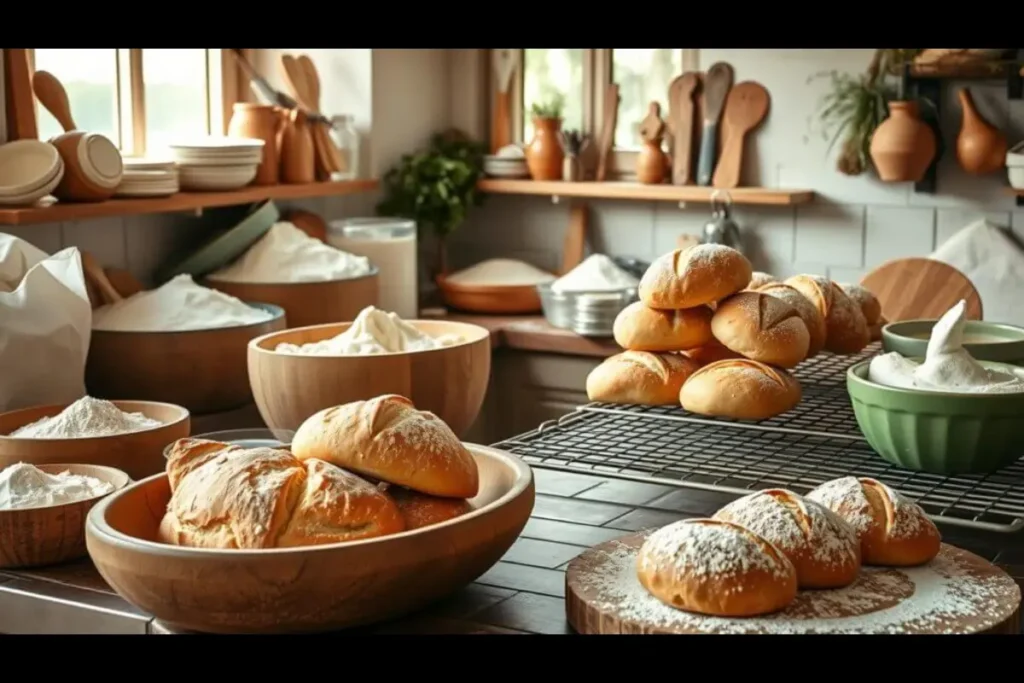European flour recipes bring a wide variety of traditional baking to our tables. From hearty breads to flaky pastries, each country has its own special touch. Exploring these recipes lets us dive into the heart of European baking.

In Italy’s green hills and France’s cozy bakeries, flour recipes are key. By using these traditional methods, we can make treats that truly capture the essence of Europe. It’s a journey of flavors and techniques that every baker should try.
Understanding European Flour Traditions
European flour traditions are deeply rooted in history and regional variations. The art of milling and baking has been passed down through generations. Each region has its own flour types and baking techniques. To truly appreciate authentic european cuisine, it’s essential to understand the historical context and regional differences.
Some key factors that influence European flour traditions include:
- Grain varieties: Different regions have access to various types of grains, such as wheat, rye, and barley, which affect the flavor and texture of flour.
- Milling techniques: Traditional milling methods, such as stone grinding, can produce distinct textures and flavors in flour.
- Regional recipes: Local recipes and baking techniques have been developed over time, often incorporating unique ingredients and methods.
The History of European Milling
The history of European milling dates back to ancient times. Evidence of grain processing can be found in ancient civilizations like the Romans and Greeks.

European vs. American Flour Classifications
American and and flour classifications differ significantly. European flours are often categorized by type and protein content. This difference can affect the outcome of european bread recipes and authentic european cuisine.
| Flour Type | Protein Content | Usage |
|---|---|---|
| Type 55 | 9-11% | Bread, pastry |
| Type 65 | 11-13% | Bread, pizza |
| Type 80 | 13-15% | Pizza, focaccia |
Essential European Flour Types for Home Baking
Choosing the right flour is key for making great European pastries and desserts. European flours have special qualities that make a big difference in taste and texture. Knowing about these flours can help you bake like a pro at home.
Home bakers often use all-purpose flour, bread flour, pastry flour, and cake flour. Each flour has a different protein level, which changes how the dough turns out. For example, bread flour is great for crusty breads because it has a lot of protein. Cake flour, on the other hand, is best for soft cakes and pastries because it has very little protein.
Here are some key characteristics of European flours:
- All-purpose flour: versatile and can be used for a variety of recipes
- Bread flour: high protein content, ideal for bread making
- Pastry flour: low protein content, perfect for delicate pastries and cakes
- Cake flour: very low protein content, ideal for tender and delicate cakes
Knowing about European flours and their uses can help you make many tasty treats. With practice, you can become a skilled baker. Your friends and family will love what you make.

| Flour Type | Protein Content | Uses |
|---|---|---|
| All-purpose flour | 10-12% | General baking, bread, cakes, pastries |
| Bread flour | 12-14% | Bread making, pizza dough, focaccia |
| Pastry flour | 8-10% | Pastries, cakes, cookies, quiches |
| Cake flour | 6-8% | Cakes, cupcakes, muffins, delicate pastries |
Classic European Bread Recipes and Techniques
European bread making is an art that needs patience, skill, and practice. There are many european bread recipes to try, each with its own flavors and techniques. From crusty baguettes to hearty rye bread, mastering european baking techniques is key to perfecting the texture and taste.
At the core of European bread making are artisanal methods passed down through generations. These methods use top-quality ingredients, precise temperature control, and a deep understanding of yeast fermentation. By learning these techniques, bakers can make a variety of breads that are both tasty and authentic.
Artisanal Bread Making Methods
Artisanal bread making uses traditional techniques to create bread by hand. This includes mixing, kneading, and shaping the dough. It also involves controlling the temperature and humidity of the baking environment. These methods help bakers make breads with a crispy crust and a soft, airy interior.
Sourdough Fundamentals
Sourdough bread uses a natural starter culture instead of commercial yeast. This gives the bread a unique flavor and texture that is tangy and slightly sour. By learning the basics of sourdough bread making, bakers can create their own starter culture. They can then use it to make a variety of delicious breads.
Some popular european bread recipes include baguettes, ciabatta, and rye bread. These breads are made using traditional european baking techniques. They are perfect for serving with soups, stews, salads, and cheeses.
Mastering European Pastry Flour Recipes
To master european pastry recipes, quality ingredients are key. High-quality chocolate, fresh fruits, and real butter can make a big difference. Using the right techniques with european pastry flour is also crucial.
Popular recipes include flaky croissants, delicate tartes, and intricate cakes like tiramisu and opera cake. These desserts need patience, skill, and detail. But the effort is worth it for the delicious results.
- Use high-quality ingredients, including real butter and fresh fruits
- Follow traditional techniques, such as lamination and fermentation
- Be patient and take the time to perfect your craft
By following these tips and practicing, you can become a skilled pastry chef. You’ll create beautiful and delicious desserts that impress everyone.
Sweet and Savory European Cookie Traditions
European cookie recipes are a big part of traditional baking. They offer a wide range of sweet and savory treats. From holiday favorites like lebkuchen and spritzgebäck to everyday treats like biscotti and madeleines, there’s something for everyone.
European cookies are known for their traditional techniques. These include laminating and cutting to create beautiful designs and textures. These methods have been passed down through generations, keeping traditional baking alive.
Holiday Cookie Recipes
Holiday cookies are a big deal in European traditions. Each country has its own special recipes and customs. For instance, Germany’s lebkuchen is a honey and spice Christmas treat, while Italy’s biscotti are a holiday favorite.
Traditional Cookie Techniques
Traditional techniques like laminating and cutting are key in European cookie making. These methods help bakers create intricate designs and textures. They’re used to make classic cookies like madeleines and spritzgebäck.
Regional Cookie Variations
Every region in Europe has its own cookie traditions. For example, France’s madeleines are made in a shell-shaped mold, while Italy’s biscotti are a regional favorite. This variety adds to the richness of European cookie traditions.
| Country | Traditional Cookie |
|---|---|
| Germany | Lebkuchen |
| Italy | Biscotti |
| France | Madeleines |
European Cake Baking Essentials
To master european cake recipes, you need to know the basics of cake baking. This includes using top-notch ingredients like european flour. You also need to learn techniques like genoise and meringue. These skills help you make a variety of tasty cakes, from Austria’s layered cakes to France’s creamy gateaux.
Important techniques include whisking and folding. They help mix in air for a light, fluffy texture. Also, the right flour, like cake flour or pastry flour, is crucial. By following these tips and practicing, you can make authentic european cuisine that will wow everyone.
- Sachertorte, a rich chocolate cake from Austria
- Black Forest cake, a chocolate cake from Germany
- Tiramisu, a creamy coffee cake from Italy
These cakes are just a few examples of the many delicious european cake recipes out there. With practice and patience, you can make your own authentic european cuisine. It will impress your friends and family.
Advanced European Flour Techniques
For those who love baking, learning advanced techniques is key. European recipes need a deep understanding of lamination, fermentation, and temperature control. These skills help make flaky croissants, crusty bread, and delicate cakes.
Some key techniques to focus on include:
- Lamination methods: folding and rolling dough to create layers of butter and dough, resulting in flaky, tender pastries
- Fermentation processes: controlling yeast activity to develop complex flavors and textures in bread, such as sourdough or rye
- Temperature control tips: precisely managing oven temperatures to achieve the perfect bake, whether it’s a crispy crust or a delicate cake
Mastering these techniques can make bakers better. They can create stunning pastries that impress everyone. With practice, anyone can become a skilled artisanal baker.
As bakers get better, they’ll learn more about European baking. They’ll appreciate the art of making amazing pastries and bread. With hard work and passion, anyone can become a master baker.
| Technique | Description |
|---|---|
| Lamination | Folding and rolling dough to create layers of butter and dough |
| Fermentation | Controlling yeast activity to develop complex flavors and textures |
| Temperature Control | Precisely managing oven temperatures to achieve the perfect bake |
Adapting European Flour Recipes for American Kitchens
Adapting European flour recipes for American kitchens comes with challenges. These include differences in ingredients, equipment, and measurements. Understanding European baking techniques is key to success in an American kitchen.
Ingredient substitution is a big concern. European recipes often use specific flours not found in American stores. But, using American flour types and adjusting amounts can work. For example, all-purpose flour can replace some European flours in recipes.
Practical Tips for Adaptation
- Use a digital scale for accurate measurements, as European recipes often use weight.
- Invest in a stand mixer or food processor for easier mixing and kneading, important in European baking.
- Try different flours, like bread or cake flour, to find the best substitute for European flour in your recipes.
By following these tips, bakers can adapt European flour recipes for their American kitchens. With practice and patience, anyone can become skilled in European baking. This includes making delicate pastries and crusty breads using European flour recipes and techniques.
Conclusion: Embracing the Art of European Baking at Home
Exploring European flour recipes and baking techniques has shown us a world of tasty possibilities. From sourdough bread to French pastries, European baking is an art form loved by many. It has been a favorite for generations.
If you love baking, keep exploring European flavors and methods. Try different flours, learn classic recipes, and add your own twist. European baking is about enjoying the process, connecting with culture, and sharing meals with others.
So, get ready to bake! Let your home fill with the smells of bread, pastries, and desserts. European baking is a journey that lets you create amazing dishes. The fun and satisfaction are endless.
FAQ
European flour is unique due to its lower protein content, traditional milling techniques, and distinctive grain varieties. Unlike American flours, which often have higher protein levels suitable for hearty breads, European flours are softer, making them perfect for pastries, cakes, and delicate baked goods. The flour is categorized by “type” numbers, such as Type 55 or Type 65, which indicate ash content and refinement level, aligning specific flours with recipes like baguettes or croissants. Traditional milling methods, like stone grinding, add texture and flavor, preserving the heritage of European baking.
European baking relies on flour types defined by ash content. Type 55 is commonly used for pastries and light breads, while Type 65 and Type 80 are ideal for pizza doughs and hearty breads. Whole-grain, rye, and spelt flours are also staples in regional recipes, offering a diverse flavor profile across Europe’s culinary traditions.
Italian flour is celebrated for its quality and precision. The finest example is “00” flour (doppio zero), an ultra-fine flour ideal for pizza and pasta. Italian grains like durum wheat enhance flavor and texture, while traditional milling techniques ensure consistency. Italian flour is also minimally processed, maintaining its purity and natural taste.
French flour balances softness and strength, ideal for both crusty baguettes and flaky croissants. Strict regulations ensure quality, while traditional stone milling methods preserve texture and flavor. Unique wheat varieties and a focus on artisanal practices make French flour an international standard for exceptional baking.

